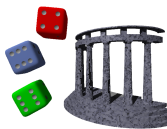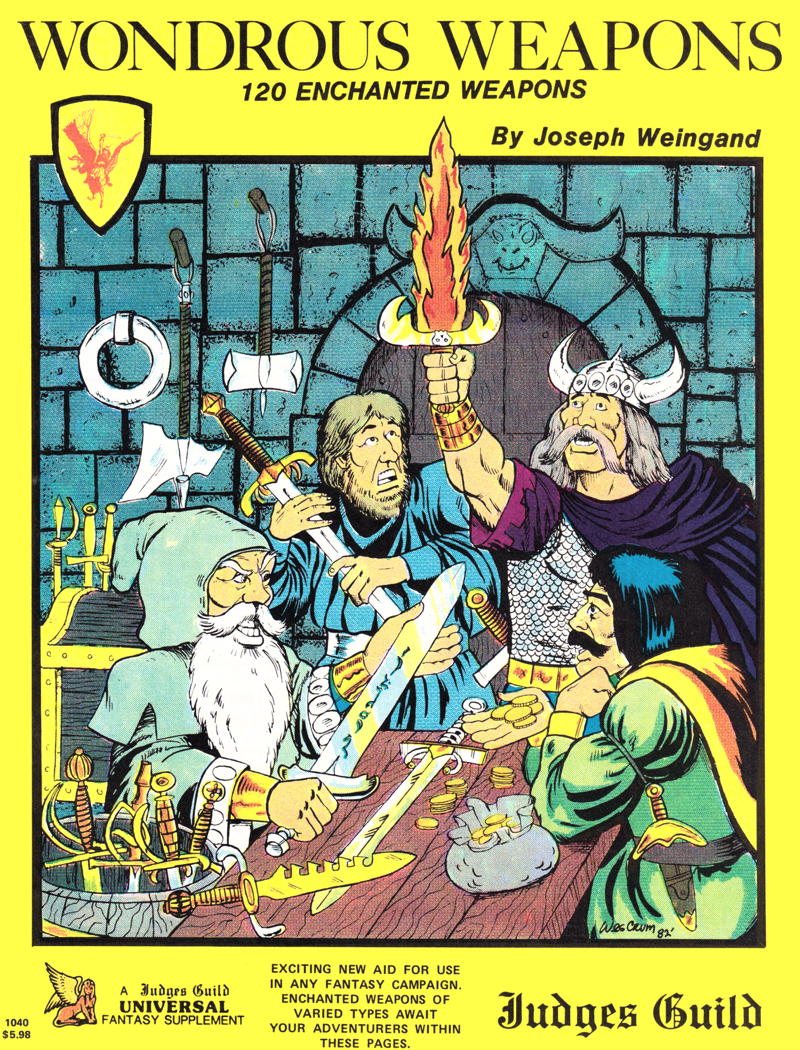Island Book 1 and old-school tables
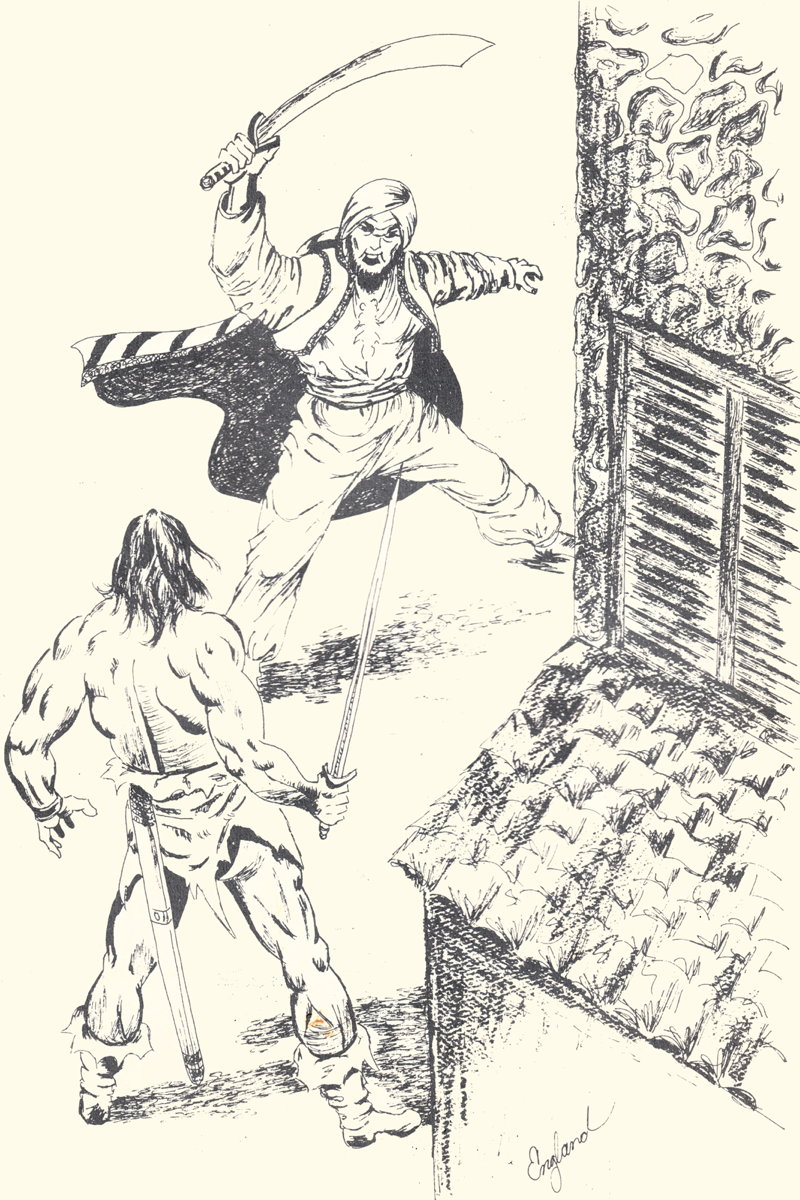
Sheryl England’s cover art is also a draw.
I managed to acquire a copy of Judges Guild’s Islands Book 1 a few weeks ago. Like most Judges Guild books, it is very interesting and very strange, and very much a product of the old school enthusiasm that permeated its era. It was published in 1978, which is still pretty early. As late as 1976, Judges Guild was still selling books from the trunk of Bill Owen’s Mustang.
It’s titled “Island Book 1”, but I can find no evidence of an “Island Book 2”. It’s a lot like their three Treasure Maps books, two Castle Book books, and Temple Book1. It’s a collection of island maps, with no keys. Some features are marked, but for the most part you’re expected to either draw your own features and keys directly on the maps, or photocopy them and draw on the copy.
You could, presumably, also use some of the included tables to generate items to correspond to the features marked on some of the maps.
They’re all filled with hexes, numbered for your amusement, part of the Judges Guild “Campaign Hexagon System”.
The cover artwork is by Sheryl England, great evocations of island-hopping adventure. The back cover is basically Sinbad vs. Conan, a great choice for sailing fantasy.
But the real draw for me is the utterly gonzo three pages of island generation tables. As soon as I saw them, I knew I wanted to make a script to generate islands.
The tables are interwoven; some results seem to indicate further rolls on other tables. This is conjecture, however: how the tables interweave is never mentioned. There are no instructions for using them. Not only are there no instructions for how to use subtables, there are barely instructions for how to use individual tables.
For example, the main table, for type of island, has a numeric range after some of the islands, such as 1-3 or 2-12. They have to be die rolls, because they correspond to the most common ranges for die rolls. But die rolls for what? For the number of islands in the chain, or for number of features that follow?
Every such entry has a list of features, such as volcanoes, mountains, hills, traps, what kinds of provisions can be scrounged on the island, and so on. I’m assuming that they are possible features, and that an entry such as “Sandy Isle (1-6) MHCT” means that this is a sandy island (that much I’m pretty sure about) that contains d6 features; those features include mountains, hills, creatures, and traps.
Other interpretations are easily imagined.
As I imagine they work, the tables end up creating something like this:
Paradisal Island
The island is 6,000 feet wide. It has a general elevation of 1,882 feet. It receives 50 inches of precipitation per year. It has a growing season of 243 days. Temperatures on the island range from 61 to 80° F. It is recognizable by a unique cliff. The weather is currently oily drizzle.
- The island is approachable through a barrier reef.
- Noise: splashing.
- Outcome of shore party: find castaway; if none on island, find provisions, unless also not available.
- If an encounter is needed near the coast, consider 65 giant sea snakes.
- The island is mountainous.
- The island is hilly.
- Three Available Provisions
- salt spray.
- salt potholes.
- hot spring (potable water).
- Multiply average precipitation by three if within 150 miles of equator.
- Reduce temperatures by 10° for every 200 miles north of the equator, and by 5° for every 1,500 feet above sea level; in the winter subtract 30%, in the spring subtract 20%, in the summer add 10%, and in the fall subtract 25%.
“Paradisal Island” is not the name of the island, but the kind of island. It’s an island paradise. That’s not, obviously, a technical term like some of the other entries on the table. It’s a guide to the Dungeon Master on how to portray the island. And while it’s not programmed into the script (or the tables from the book), the random rolls that follow did indeed create a paradise. Temperatures range from 61° to 80°. There’s a barrier reef that protects it from storms, making it a great place to dock. There are mountains and hills and even a hot spring that’s not poisonous. On the down side, it’s also rainy and the barrier reef is potentially infested with giant sea snakes.
Here’s another example:
Atoll Ring Reef
The island is 9,100 feet wide. It has a general elevation of 652 feet. It receives fourteen inches of precipitation per year. It has a growing season of 285 days. Temperatures on the island range from 81 to 100° F. It is recognizable by a unique cave entrance. The weather is currently torrent.
- The island is approachable through light winds.
- Noise: wailing.
- Outcome of shore party: find recluse; if none on island, find provisions, unless also not available.
- If an encounter is needed near the coast, consider one giant squid.
- Dominant creature: paleocincus.
- Multiply average precipitation by three if within 150 miles of equator.
- Reduce temperatures by 10° for every 200 miles north of the equator, and by 5° for every 1,500 feet above sea level; in the winter subtract 30%, in the spring subtract 20%, in the summer add 10%, and in the fall subtract 25%.
This much-less paradisal island greets the players wailing. It’s always hot. And the dominant creature is an obscure dinosaur… well, no island is all bad.
Some of the results are further extended with other tables, and some aren’t. There is, for example, a table of “Mysterious Finds”, and a 20% chance per day of finding something on it while marooned. If a passing ship is rolled, there’s a table for passing ships. There’s a table for recluses, and for castaways. If skeletons are rolled, there isn’t a subtable. Nor is there one for leather thongs and kegs. And I wouldn’t expect one.
The superficial reason is that it is entirely up to the Dungeon Master what skeletons, leather thongs, or broken kegs represent. You could use one of the people-oriented tables to see where the thongs and kegs came from—I chose not to do that with the script—or you could just pull something out of the air, or out of the party’s past adventures, or out of the rest of what’s on the island. Saying that some things were left up to the Dungeon Master to make up is missing the point of this sort of free-wheeling collection of tables. Everything was left for the Dungeon Master to make up, whether it had a subtable or not.
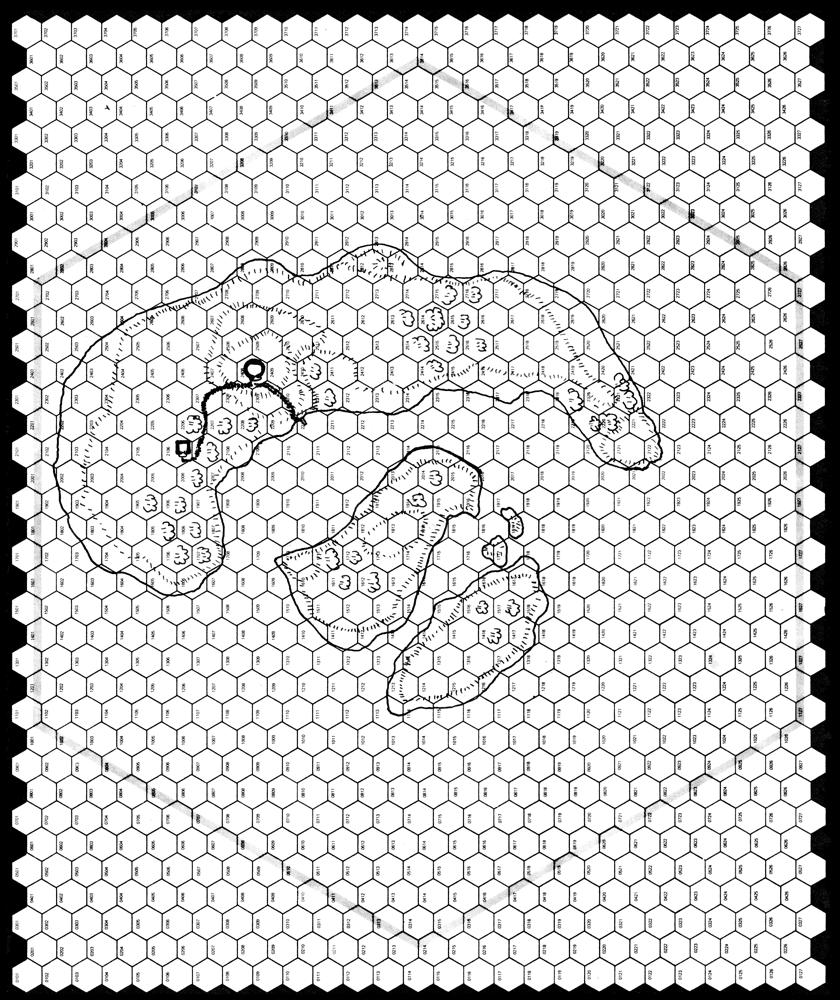
The maps are meant for quickly pulling out when you already know what needs to be on the island, you just need an outline to put it on.
I’m also guessing that the DM is expected to replace finds with other finds once they’ve come up too often. Or dominant creatures, because as it stands the dominant creature on 1 in 20 islands is the giant toad and on another 1 in 20 islands, the paleocincus.
NTTAWWT.
Nowadays, you would expect to see an explicit “roll on Castaway table” instruction if the “Mysterious Finds starving castaway” is meant to be rolled just as the “Isle Inhabitants castaway” is. I wouldn’t be at all surprised if the “castaway” table in this book is meant specifically for the isle inhabitants—they’re both in the same row—and not for the mysteries.
I also wouldn’t be surprised if the authors would be completely surprised at the suggestion of an explicit instruction for any of those guesses. These are tools. They are to be used where they help, and not where they don’t. What that means will change from DM to DM, from game to game, and from session to session.
More incomprehensible text shows in the available provisions table, and even where the text is technically easily understood, context is missing. For example, many of the provisions are sources of water, such as a hot spring or a warm spring or a caldera lake. Each is followed by a parenthetical “80% Prob” or “100% Prob”. I assume that “Prob” is short for “probable” or “probability”, but probability of what?
Beneath that table is another table for kinds of non-potable water, so on first glance it looks like a probability that the water is non-potable. This would mean that limestone springs are always non-potable, however, which is a strange result. So, perhaps, it’s the chance that the water is drinkable? That’s what I ended up going with.
Similarly, the Coastal Encounters table provides interesting coastal encounters—but no other table references it. So I had the script provide a coastal encounter as “if a coastal encounter is needed, consider…”.
I’ll have more about how I wrote this script and what it does in the next installment, but for now let me say that it is far from an example of well-written, organized code. It’s as messy as the old-school tables it encapsulates. Judges Guild products ran along a wide range of quality, even within individual books. Most companies back in the day were gamers first, publishers second. Editing and proofing took time away from gaming.
Playtesting was nonstop—but getting the results of playtesting on paper was a task that often assumed knowledge on the part of the reader that only the writer could possibly have. In other cases, playtesting only revealed “well, that’s what we did”, something not worth writing down because everyone does it differently.
The boundaries between publisher and player were indistinct.
In many ways, third-party gaming books from this era are a lot like the older cookbooks I also collect. Even for the time, they leave a lot out that the writer assumed everyone knew. They also leave out a lot that the writer didn’t even know they left out. It was such common knowledge it wasn’t recognized as knowledge.
These cookbooks and these game books assume a culture that has since changed considerably, to the point where much of what was used then requires re-entering that culture; they are impenetrable otherwise.
And much of the culture can’t be re-entered, because it’s lost.
Much of what I’ve semi-complained about here, such as the orphaned “coastal encounters” table, probably wasn’t a bug. The authors likely assumed, the Dungeon Master is rolling d6 every sea turn, and when a one comes up, they need a sea encounter table. And that everyone knows this.
The same with the superficially common weird encounters. One in 20 islands does not contain a “dubious genus of ankylosaur”. The DM is expected to alter these tables over time. They’re expected to change them on the fly to whatever their own favorite dinosaur is today.
This is very different from later tables, even from Judges Guild. In the same purchase, I also got the 1982 Wondrous Weapons. Four years makes a big difference. There’s a very similar, in purpose, set of tables for creating unique weapons. Each table is numbered, so you know where to start; it is filled with references to “see Sub Table xx”. Those tables would be far easier to program, which of course makes them less interesting.2
Island Book 1 appears to be available as a reprint from Judges Guild; it looks like they have a handful of the other themed map books reprinted also. I’ve not ordered any of them, however, so I have no idea how well their store works or if it’s still in operation.
Next up: how I wrote the islands script.
- October 18, 2023: Wondrous Weapons of Ancient Days
-
Wondrous Weapons, by Joseph Weingand, is a collection of weird and often unusable weapons for fantasy games. It’s also a fascinating glimpse into old-school treasure and old-school play styles.
Wes Crum’s front cover is very reminiscent of Dave Trampier’s treasure illustration in the AD&D Players Handbook, in that there are a variety of emotions expressed on the character faces. It is less technically adept than the back cover (and far less than even the worst of Trampier’s illustrations) but also more fun than the back cover. Neither are up to the level of Trampier, of course.
The entries use the Judges Guild universal system to present the stats of the weapons, but without the one-or-two page explanation that usually accompanies it. And you really do need the explanation to decipher the stats. What is an INT of 184? An ALN of NEX or NGC?
These were not easy to decipher without the conversion summary. An INT—or intelligence—of 184 means an intelligence of 18, which can be used four times a day “without checking for stress damage”. The ALN is the alignment, and it’s vaguely Freudian. The first two letters indicate the alignment that most AD&D players would recognize. The third letter “indicates only a suppressed desire”. So, NEX is Neutral Evil with no suppressed alignment, while NGC is Neutral Good with a suppressed desire to be Chaotic.
The proliferation of universal systems was a fascinating byproduct of the times. They were rarely universal. They were meant solely to make it easier to convert to AD&D without saying AD&D. You can see that in Wondrous Weapons, where the stat numbers—mostly intelligence—tend to be in the 3 to 18 range. And, of course, the use of an alignment system of Chaotic/Neutral/Lawful and Good/Neutral/Evil.
The need for a universal system that really only applies to one game, when publishing supplemental material, appears to have been based on either a poor understanding of copyright law or a very good understanding of the litigious nature of the gaming industry. If you’re a small company, after all—and Judges Guild was very small—knowing you’re right doesn’t matter if you have neither the money nor the inclination to defend yourself.
Most early gaming companies were gamers first, companies second. A letter from a corporate lawyer, especially in pre-Internet days, was a very frightening and demoralizing experience.
- July 5, 2023: Quick-and-dirty old-school island script
-
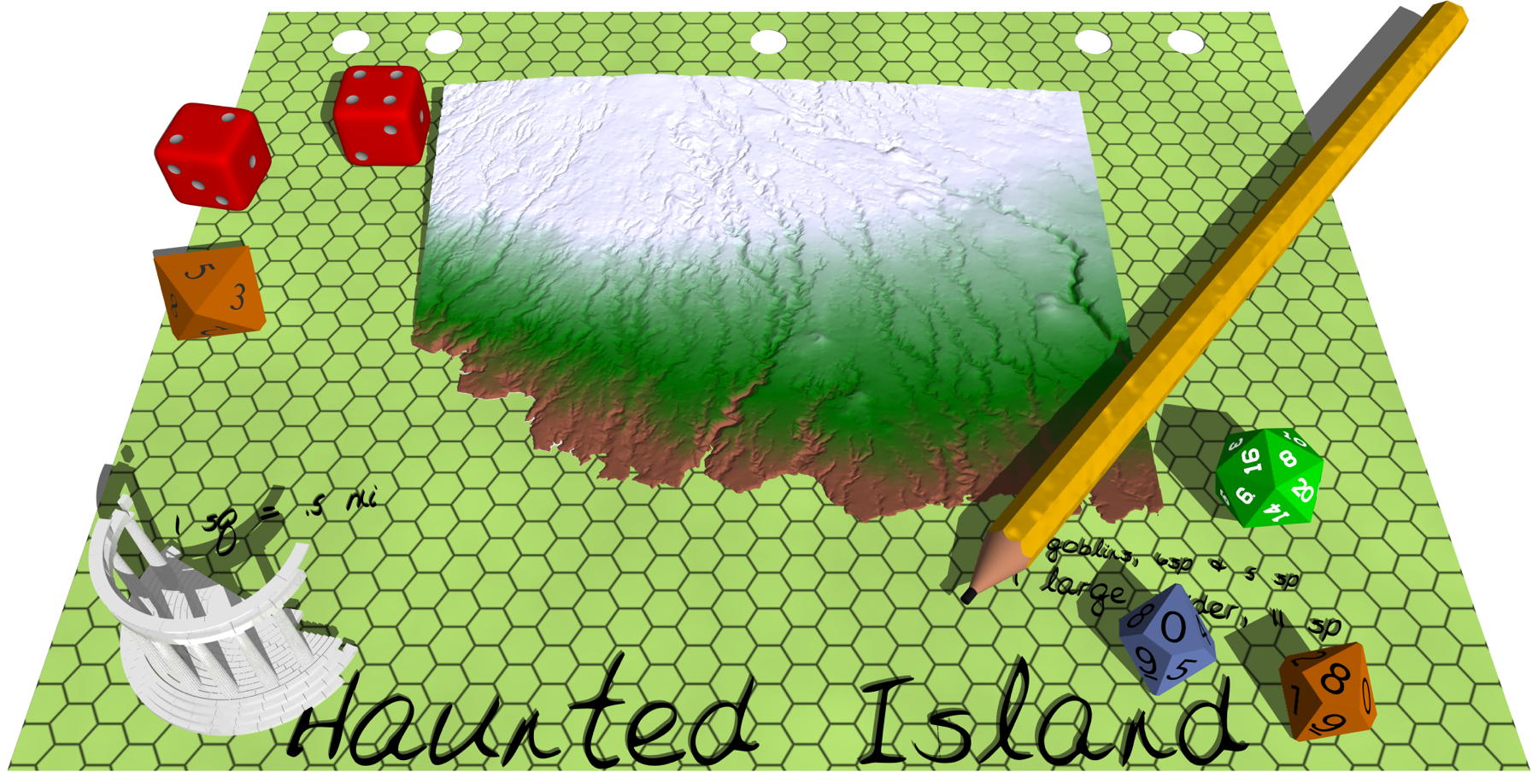
Islands are great locations for adventures, especially weird ones or constrained ones, which is why I chose an island for the cover of The Adventure Guide’s Handbook.
As I wrote in the first installment, this island generator (Zip file, 6.9 KB) is far from an example of well-written, organized code. It’s as messy as the old-school tables from Island Book 1 it encapsulates. The data is not separate from the code, and the code is filled with special cases.
If this had been a serious effort, I would have flowcharted the tables, organized them into kind of table, and probably made a series of table classes and subclasses for the different kinds of information in the tables—whether they call for die rolls to determine number, or whether the call for rolling on a further table, for example.
For something like this, that’s a recipe for never getting the script done. So I went along table by table and created code for what each table needed. If it was similar to the code that a previous table had needed, I modified that code, perhaps adding a new, optional, function parameter.
I could almost certainly have used the file-based table script I wrote about in my Programming for Gamers series. It would have been cleaner and smoother. But part of what drew me to these three pages of tables were all of the rough edges. I had to sand some of them off just because it’s a computer program—decisions have to be made—but I wanted to keep as many of the dangerous bits as I could.
Most of the tables are simply a list of 20 items, to be generated using a d20. Those are simple. The list of items is a Python list, and
item = random.choice(list)pulls an item randomly from the list.Some of the 20-item lists also have options within the list. For those, I made the simple 20-item list a slightly less simple 20-item list of lists. The top table, the list of twenty types of islands, includes, in some entries, a range of numbers and/or a list of island features types.
Which is also titled with a one and does not appear to have a two. “Caves and Caverns” and “Ruins” were the same basic idea, but were unnumbered. Consistency is the hobgoblin of gamers who have too much free time because they don’t play often enough.
↑They’re still fascinating, however. Where else are you going to find a lariat made of orichalcum that slices through warm metal, thus ignoring armor?
↑
- Ankylosaurus and Paleocincus
- Said paleocincus to ankylosaur, “there’s a big bony knob on your tail, what’s it for?” Said ankylosaurus, “I use it to fight and to scare off meat eaters who come for a bite.”
- Island Book 1 reprint: Bill Davis and Bob Bledsaw, Sr. at Judges Guild (paperback)
- “Island Book I (originally published in 1978 and out of print since 1985) is a 62-page booklet which includes 48 detailed Maps (all digitally restored) of small island groups and atolls for adventuring.”
- Island Book I at The Acaeum
- “This booklet includes 48 pages of small island groups and atolls for adventuring: passing ships, damaged by storms, may drop anchor here for repairs or be breached on the rocks, marooning their crewman; or it may be the stronghold of pirates, the sanctuary of a secret religion, or a coven of witches.”
- Wondrous Weapons reprint: Joseph Weingand at Judges Guild (paperback)
- “120 Enchanted Weapons for use in your campaigns. These make excellent additions to any treasure trove or forgotten tomb.”
More Judges Guild
- Quick-and-dirty old-school island script
- Here’s a Python-based island generator using the tables from the Judges Guild Island Book 1.
- Skin a module 3: Thracia to The Lost City
- The Judges Guild module Caverns of Thracia is one of the classics of the old-school. It’s also eminently reskinnable by changing the names of gods and expanding on some of the magic items hidden inside.
- Knee deep in monster frogs: A Judges Guild history
- Bill Owen, one of the early members/employees of Judges Guild, has created an amazing color collection of old Judges Guild artifacts: maps, designs, and more from the early days of JG.
More old-school
- Knee deep in monster frogs: A Judges Guild history
- Bill Owen, one of the early members/employees of Judges Guild, has created an amazing color collection of old Judges Guild artifacts: maps, designs, and more from the early days of JG.
- Tractor Feed Adventures
- Old adventures, not worth converting to Gods & Monsters. I haven’t played these since the eighties.
- Old School Cool
- Since I first made Gods & Monsters public over ten years ago, there’s been a groundswell of support for “old-school” D&D games. Since Gods & Monsters is compatible with adventures for original D&D and AD&D, it’s also compatible with adventures for most of these new games.
More random tables
- Random table rolls
- As often as not, when you roll on a random table you are rolling a random number of times. Now that we have a dice library, we can turn the roll count into a die roll.
- Percentage-based random tables
- Our current random item generator assumes that each item shows up as often as any other item. That’s very OD&D-ish. But AD&D uses percentage dice to weight toward some monsters and items more than others.
- Wandering monster chart assistant
- Use the encounter chart assistant to create wandering monster charts using percentages rather than ranges. Copy your tables into this tool to make sure they add up, adjust them, then copy them back out to your word processor. Never worry about missing or overlapping ranges again!
- Multiple tables on the same command
- The way the “random” script currently stands, it does one table at a time. Often, however, you have more than one table you know you’re going to need. Why not use one command to rule them all?
- Easier random tables
- Rather than having to type --table and --count, why not just type the table name and an optional count number?
- Three more pages with the topic random tables, and other related pages
